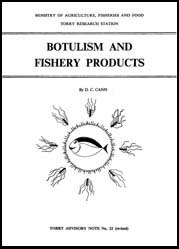Contents Index

Accompanying Notes
Table of Contents
By D. C. CANN
MINISTRY OF AGRICULTURE, FISHERIES AND FOOD
TORRY RESEARCH STATION
TORRY ADVISORY NOTE No. 22 (revised)
Crown copyright material is reproduced with the permission of the Controller of Her Majesty's Stationery Office.
This electronic document has been scanned using optical character recognition (OCR) software and careful manual recorrection. Even if the quality of digitalisation is high, the FAO declines all responsibility for any discrepancies that may exist between the present document and its original printed version.
Defines botulism, refers to the occurrence of Clostridium botulinum in fish, and discusses the likelihood of outbreaks of botulism. Emphasises that the risk is remote although there is no room for complacency, and explains the precautions necessary, particularly with smoked fish products that may be eaten without further cooking. Note that reference to the incidence of botulism in the UK relates to the period prior to 1977. This Note is particularly relevant to Notes 5, 66, 74, 82, 88 and 93.
More recent advice notes that the growth of Clostridium botulinum is inhibited in foods stored below 10°C at salt concentrations above 3.5 % w/w in the water phase of the product, and that this concentration should therefore be the minimum in products intended for consumption without further cooking, such as cold-smoked salmon, and hot smoked trout and mackerel. For the safety of smoked fish products in general, it is recommended the products are kept chilled below 5°C throughout the distribution chain until eaten. Further information about the important distinction between salt content of the flesh and salt concentration in the water phase can be found in Notes 66, 74 and 82. The following practices should always be part of process control:
(FAO in partnership with Support unit for International Fisheries and Aquatic Research, SIFAR, 2001).
Introduction
What is botulism?
Clostridium Botulinum in fish
Outbreaks originating from hot-smoked fish
The possible danger in the UK
Time taken in days for experimentally inoculated products to become toxic
Smoked fish and botulism
How to control botulism
Summary
Contents Index